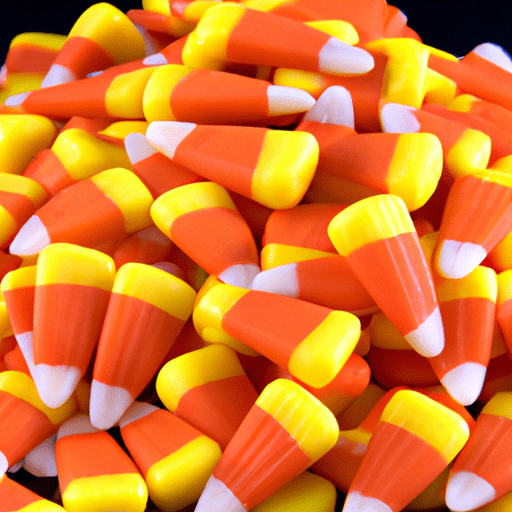The Sweet Brilliance of Candy Corn
Candy corn is a beloved treat that is synonymous with Halloween, but have you ever wondered about its origins or how it can be used in cooking? In this article, we’ll explore the captivating world of candy corn, taking a closer look at its taste, versatility in the kitchen, nutritional value, and a few intriguing facts. So, grab a handful of this colorful confection and let’s dive in!
A Symphony of Sweetness
Candy corn is a small, tri-colored candy made to resemble a kernel of corn. Its signature hues of orange, yellow, and white create a vibrant visual spectacle that is both whimsical and inviting. But what about its taste?
Although it may seem simple, the flavor profile of candy corn is surprisingly complex. With a delectable mixture of sweetness and creaminess, candy corn has a unique taste that instantly transports you to a state of nostalgic bliss. Each bite delivers a burst of sugary fondness, with a subtle honey-like aroma that lingers on your taste buds.
Creative Uses in Cooking
While candy corn is undeniably delightful on its own, it can also be an exciting ingredient to experiment with in the kitchen. Here are a few creative ways to incorporate candy corn into your cooking repertoire:
1. Sweet and Salty Popcorn Mix
Combine freshly popped popcorn with candy corn for an irresistible blend of sweet and salty. The crunchy texture of popcorn complements the chewy candy corn, offering a pleasurable contrast that will keep you reaching for more.
2. Festive Cupcake Toppings
Transform simple cupcakes into eye-catching masterpieces by adorning them with candy corn. Simply arrange a few pieces on top of the frosting, and watch as your desserts come to life with vibrant colors and a playful touch.
3. Trail Mix Medley
Upgrade your trail mix game by adding candy corn to the mix. Its burst of sweetness pairs perfectly with nuts, dried fruits, and chocolate chips, offering a delightful surprise with every handful.
Nutritional Value
While candy corn certainly satisfies our cravings for something sweet, it’s essential to be mindful of its nutritional value. Here’s a glimpse into the macronutrient profile of this popular treat:
- Calories: A 19-piece serving of candy corn typically contains around 140 calories, so enjoy it in moderation to maintain a balanced diet.
- Sugar: Candy corn is predominantly made of sugar, so it’s not surprising that it is considered a high-sugar treat. Each serving is estimated to have about 28 grams of sugar.
- Fat and Protein: Candy corn is virtually fat-free and contains negligible amounts of protein, making it a treat that is low in these macronutrients.
Remember, candy corn should be enjoyed as an occasional indulgence rather than a dietary staple, given its high sugar content.
Interesting Facts and History
Candy corn has a rich history that dates back over a century. Here are a few intriguing facts to pique your curiosity:
- Ancient Roots: Confections resembling candy corn can be traced back to ancient civilizations, who used honey, sugar, and wax to create similar treats.
- Handcrafted Perfection: When candy corn was first introduced in the late 1800s, it was entirely handmade. Now, modern production methods allow for mass production of this iconic candy.
There you have it – the enticing world of candy corn in a nutshell. From its unparalleled sweetness to its potential as an ingredient in cooking, candy corn continues to captivate all who encounter it. So, whether you enjoy it by the handful, experiment with it in the kitchen, or simply admire its vibrant colors, candy corn is a classic treat that brings joy to any occasion.
Candy Corn
Origin: Candy corn is a popular candy that was first created in the late 1800s by George Renninger and John W. Schott, two candy makers from the Wunderle Candy Company. The original intent was to create a candy that resembled corn kernels and could be enjoyed year-round.
Common Uses: Candy corn is most commonly associated with Halloween, often being used as a decorative element for treats, as well as being given out as a trick-or-treat candy. It is also enjoyed during other fall and harvest-themed celebrations. Some people also use candy corn as an ingredient in baking and desserts, such as cookies and cupcakes.
Nutritional Benefits: Candy corn is primarily made up of sugar, corn syrup, and confectioner’s glaze. It is a high-calorie candy with no significant nutritional benefits. A typical serving (about 19 pieces) contains around 150 calories, 0 grams of fat, and 38 grams of carbohydrates.
Unique Properties: One interesting fact about candy corn is its tri-color design, which consists of a yellow base, an orange center, and a white tip. This iconic layering is achieved by pouring the different colored syrups into molds during the candy-making process. Another noteworthy aspect is that candy corn has a somewhat waxy texture and is often praised for its unique combination of sugary sweetness and subtle honey-like flavor.
Historical Significance: Candy corn quickly gained popularity and became one of the most iconic candies associated with Halloween. Its production expanded in the early 1900s when the Goelitz Candy Company (now known as Jelly Belly Candy Company) started mass-producing candy corn. Today, candy corn remains a beloved Halloween treat and a significant part of American candy culture.




Use the share button below if you liked it.
It makes me smile, when I see it.